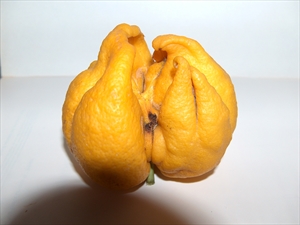Citrus bud mite
Pacific Pests, Pathogens, Weeds & Pesticides - Online edition
Pacific Pests, Pathogens, Weeds & Pesticides
Citrus bud mite (393)
Aceria sheldoni. Previously, the mite was known as Eriophyes sheldoni.
Asia, Africa, North and South America, the Caribbean, Europe, Oceania. It is recorded from Australia, Fiji, New Zealand, and Papua New Guinea.
Citrus species, in particular, lemon and navel oranges; less on grapefruit. In New South Wales, Australia, infestations of Valencia oranges and mandarins is low.
A mite belonging to the Eriophyid family that feeds in leaf and flower buds. The buds become thickened, twisted and bunched, and the blossoms deformed. As the fruits develop, the mites puncture the rind, feeding on the cell contents, and cause distortions and deep longitudinal grooves (Photo 1). There may be more than 100 mites in a bud. Severe attack results in fruits losing water, reduction in size, death and premature fruit drop. In Fiji, Swaine (1970)1 reports that the worst damage occurs on the spring flush of leaves.
The mite is creamish white, cigar-shaped, 0.16 mm long, with two pairs of legs near the front end. Females lay up to 50 eggs, singly in the bud scales, which hatch after 2-5 days and feed inside the buds, passing through four nymph stages before adult. The life cycle is about 10-15 days.
Spread occurs as the mites move over the plant surface, but spread over greater distances occurs in rain splash, and further still on wind currents, birds, insects, machinery, and clothing of human beings. The trade in plants and plant parts, both domestically and internationally, is also a means of long-distance spread.
In Fiji, the damage is relatively minor, although there have been cases of severe damage on lemons. Lemon is also the preferred host in other parts of the world and, for instance, the European Plant Protection Organisation, EPPO, considers the mite to be one of the main pests of this host. Apart from direct damage, the mite allows further damage by mealybugs and spider mites.
Look for bunched (rosette-like) leaves and distorted flowers; look for leaves that vary in shape and have irregular margins. Look especially for grossly deformed fruit, often with deep grooves on lemon. Note, bud dissection is needed to see the mite, and then a microscope or 20x lens.
NATURAL ENEMIES
Predatory mites, Euseius and Amblyseius species, are known to suppress populations of citrus red and rust mites in Australia, but there is little information about their effectiveness against citrus bud mites or that of any other species. However, the use of pesticides should be kept as a last resort in order to protect any beneficial predators that may be present.
CULTURAL CONTROL
During plant growth:
- Monitor plant growth and prune infested shoots as soon as symptoms are seen. Collect and burn the shoots to avoid spreading the mites.
CHEMICAL CONTROL
Consider using a pesticide before there are large infestations. But note, spraying will kill predatory mites and may upset biological control and make the situation worse. Only spray those trees where the infestation needs to be brought under control, not every tree if there is no need.
If pesticides are needed, consider the following:
- Use lime sulphur (polysulphide sulphur) or wettable sulphur; leave at least 30 days between spraying lime sulphur and sprays of oil. Take care to follow manufactures' instructions as sulphur can burn the leaves.
- Alternatively, use white oil (made from vegetable oils), soap solution, or horticultural oil (made from petroleum) (see Fact Sheet no. 56). If possible, spray before flowering or the time of maximum flush of leaves and flowers.
-
White oil:
- 3 tablespoons (1/3 cup) cooking oil in 4 litres water
- ½ teaspoon pure hand soap, not detergent
- Shake well and use.
- Soap:
- Use soap (pure soap, not detergent):
- 5 tablespoons of soap in 4 litres water.
-
- Commercial horticultural oil can also be used. Usually, mite infestations are controlled using a number of low concentration (0.25-0.5%) oil sprays. White oil, soap and horticultural oil sprays work by blocking the breathing holes of insects and mites causing suffocation and death. There may be changes to feeding and egg-laying behaviour. Spray the undersides of leaves; the oils must contact the mites. A second application of soap or oils may be necessary after 3-4 weeks.
- Be careful to follow manufacturers' instructions if using a commercial horticultural oil or a white oil. Do not apply oils where temperatures are higher than 35°C or where trees are moisture-stressed. Never mix with other pesticides without checking compatibility.
- Alternatively, use abamectin, a miticide/insecticide, made from a soil bacterium.
____________________
When using a pesticide, always wear protective clothing and follow the instructions on the product label, such as dosage, timing of application, and pre-harvest interval. Recommendations will vary with the crop and system of cultivation. Expert advice on the most appropriate pesticides to use should always be sought from local agricultural authorities.
AUTHOR Grahame Jackson & Mani Mua
1Information from Swaine G (1971) Agricultural Zoology in Fiji. Her Majesty's Stationery Office. London; and Mite pests of citrus (2003) Agfacts NSW Agriculture. Mite pests of citrus. (http://www.dpi.nsw.gov.au/__data/assets/pdf_file/0006/138705/mite-pests-citrus.pdf); and Using petroleum-based spray oils in citrus (2005) Agfacts NSW Agriculture. (https://www.dpi.nsw.gov.au/__data/assets/pdf_file/0009/137646/petroleum-sprays-citrus.pdf); and Aceria sheldoni. Wikipedia. (https://en.wikipedia.org/wiki/Aceria_sheldoni); and from EPPO Standards (PP2/27(1) (2004) Bulletin 34, 43-56. (https://gd.eppo.int/taxon/ACEISH/documents). Photo 1 Giancarlo Dessi (2007) Damage of Aceria sheldoni (Acari: Eriophyidae) on lemon. (https://commons.wikimedia.org/wiki/File:Aceria_sheldoni_3.jpg).
Produced with support from the Australian Centre for International Agricultural Research under project HORT/2016/18: Responding to emerging pest and disease threats to horticulture in the Pacific islands, implemented by the University of Queensland and the Pacific Community.




